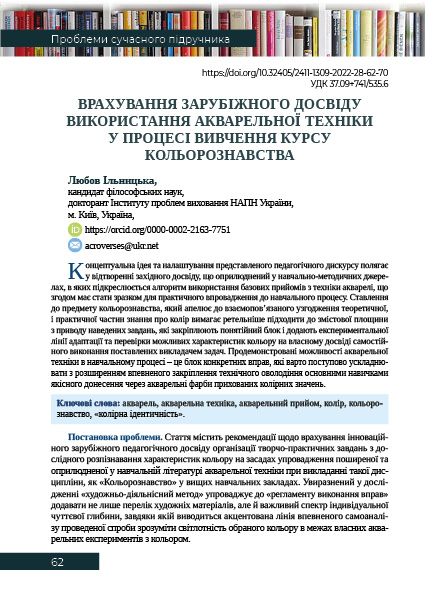Considering the foreign experience of using watercolor techniques in the process of studying the “color science” course

Published 2022-07-20
Keywords
- watercolor,
- watercolor technique,
- color,
- color science,
- “color identity”
How to Cite

This work is licensed under a Creative Commons Attribution-NonCommercial-ShareAlike 4.0 International License.
Abstract
The conceptual idea and setting up of the presented methodological development is to reproduce such an algorithm of actions, which should later become the basis for practical implementation in the educational process. The attitude to the subject of color studies, which appeals to the interrelated coordination of theoretical and practical parts of knowledge about color requires a more careful approach to the content of the tasks, which consolidate the conceptual block and add an experimental line of adaptation and verification of possible color characteristics tasks set by the teacher. Presented watercolor blurs are a block of specific exercises that can be gradually complicated with the expansion of confident consolidation of technical mastery of basic skills of quality communication through watercolor paints of hidden color values. It should be noted that there is a classification of such blurs, which in the educational process cover many necessary theoretical aspects. Thus, the creative potential of this method of studying the typical properties of color significantly helps in the transition to another more creative stage of self-affirmation of students with easy mastery of the primary type of watercolor pronunciation – only at first glancelight blurs, receptions announces a higher level of readiness to disclose their professional abilities.
The educational reception of “artistic activity” underlined in the recommendations introduces the rules of exercises to add not only an arsenal of key artistic materials, but also an important range of individual sensory depth, thanks to which an accentuated line of watercolor experiments with color. Filling options have already been analyzed mostly by Western educators. Thus, the usefulness of these variations affects a variety of nuances, which undoubtedly attract more innovative approaches to the learning process. This methodological approach may be the key to inventing an optimal systematized complex for teaching the theoretical foundations of color science.
Downloads
References
- Баталія, І. (2020). Вправи-досліди на початковому етапі вивчення техніки акварельного живопису в мистецьких школах. Розвиток творчої компетентності учнів мистецьких шкіл. Від традицій до інновацій: матер. всеукр. наук.-практ. конф., м. Херсон: Графіка, 154–159.
- Ган, Н., Казанцев, А. (1971). Малювання з натури. Київ: Радянська школа.
- Григор’єва, В. (2021). Використання новітніх акварельних матеріалів у художній підготовці архітекторів. Стан, проблеми та перспективи розвитку сучасних міст: матеріали міжн. наук.-практ. конф., м. Одеса, 59–61.
- Кириченко, М., Кириченко, І. (2002). Основи образотворчої грамоти. Київ: Вища школа.
- Павлов, В. (1978). Сучасна українська акварель. Київ: Мистецтво.
- Donaldson, D. (2018). The Art of Creative Watercolor. North Light Books.
- Haines, J. (2015). The world of watercolors. Search Press Ltd.
- Jennings, S. (2005). Painting: from sketch to painting. Harper Collins Publishers Ltd.
- Keck, U. Aquarell (2022). URL: https://www.artists24.net/portfolio.php?id=6889
- Smite, R. (1995). An introduction to art techniques. Dorling Kindersley Limited.
